[Click on BLUE links for sources and more information]
I love oysters. I like them raw, also fried and in soups or stuffing, but I’ll eat them most any way they are served. At the Sea Gull we served them more or less the same way we served the Sweetbreads. They were also an ingredient in our Bouillabaise (recipes below).
Tough guys eat oysters as you can see in this clip from the 1975 movie Hard Times. The vagabond Chaney (Charles Bronson) introduces himself to hustler Speed (James Coburn) in an early scene from the Walter Hill depression-era fistfight drama.
Lots of people eat oysters, not just tough guys. The Danish writer Isak Dinesen lived on oysters, white grapes and champagne in her last years. A famous dinner with Isak Dinesen, Marilyn Monroe and Carson McCullers is documented HERE (Lunch with Carson).
Some believe oysters improve sexual potency. “The literary lover Casanova claimed to eat fifty oysters for breakfast each day. His mistress would bring them to his bath and he ate them off her breasts” according to Oyster: A Gastronomic History (With Recipes), the definitive book on oysters by Drew Smith.
The highest quantity of mineral in an oyster is zinc, which protects and supports the immune system, helps to heal wounds, and promotes general growth, especially in pregnancy and childhood … Low levels of zinc have been linked to impotence and in some cases restoring the zinc level has resulted in a recovery of potency. Drew Smith
Lisa Rosman in A Literary Ode to Oysters: 10 Books Inspired by These Shelled Creatures has this to say about Tipping the Velvet by Sarah Waters:
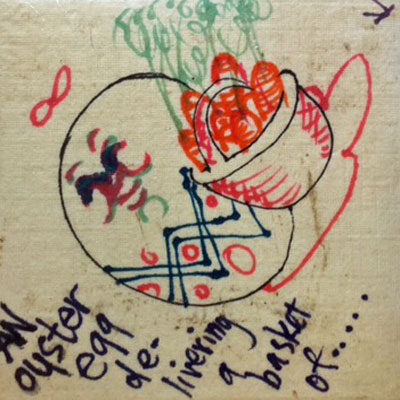
Sea Gull Cellar Bar Napkin Art, artist unknown
Few authors have captured the hypnotic pleasures of the historically forbidden act of lesbian sex as well as author Sarah Waters. This, her debut novel, is the first-person tale of an 1890s English oyster girl who finds her way onstage and between famous women’s sheets. The girl writes: “Have you ever tasted a Whitstable oyster? If you have, you will remember it. Some quirk of the Kentish coastline makes Whitstable natives – as they are properly called – the largest and the juiciest, the savouriest yet the subtlest, oysters in the whole of England?” Houston, I don’t think we’re just talking about mollusks anymore…
Drew Smith explains in his book Oyster (cited above) why the oyster is such a wonderful and healthful source of food:
The way an oyster feeds makes it a highly nutritious food. Dietary textbooks hopefully recommend them for the young, the infirm, and the elderly. The prospect of a granny shucking oysters in her armchair, or a mother slipping an oyster into a sick child’s supper, may smack of nutritional hubris, but it was a familiar recommendation from old apothecaries, and the analysis is solid enough. The oyster would also have made an ideal food for sailors, settlers, fishermen, and early nomadic natives. A dozen oysters can amount to fewer than 100 calories but are worth as much in protein as a 4-ounce (100-g) steak and contain as much calcium as a glass of milk … The cocktail of vitamins that an oyster provides would have been a viable alternative to fruit and vegetables, and would help stave off diseases like scurvy, particularly for early sailors … Vitamin B12 influences nerve cell activity, the metabolism in general, and DNA replication, and it improves your mood. It is often prescribed as an aid for depression.
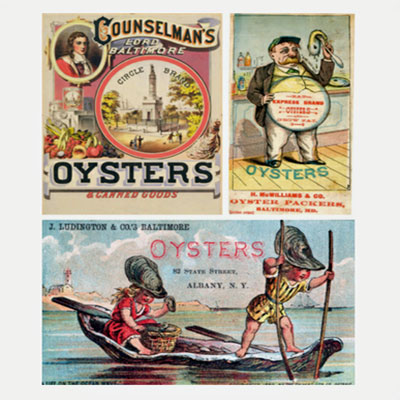
Posters and Ads for Oysters, source Drew Smith
At the Sea Gull we described the oysters on our menu as “fresh, specially breaded and cooked in butter.” We dipped the oysters in an egg wash, rolled them in freshly made cracker crumbs, and fried them at moderate heat in an electric skillet until they were golden brown. At some point we decided that we should have a fish stew on the menu. Fishing is one of the major industries and sources of employment on the Mendocino coast. It seemed only natural to have a warm and pleasing fish stew to complement our other items.
BOUILLABAISSE
1 bunch green onions, chopped
4 chopped yellow onions
4 chopped carrots
1 bunch celery chopped
1 pound (give or take) of sautéed mushrooms
1/2 cup butter
2 cups white wine
2 – 5 quarts fresh fish stock
1 #10 can tomatoes versatile (crushed tomatoes)
salt, pepper, saffron
fish, shell fish, clams, oysters
Sweat the vegetables in the butter, add mushrooms
Add the wine and simmer until alcohol dissipates
Add fish (white fish will vary depending on availability)
Add fish stock as needed to achieve proper consistency
Add fresh clams with shells
Add shucked oysters
The actual ingredients (fish and spices) varied from time to time depending on the season and availability and the chef’s preferences
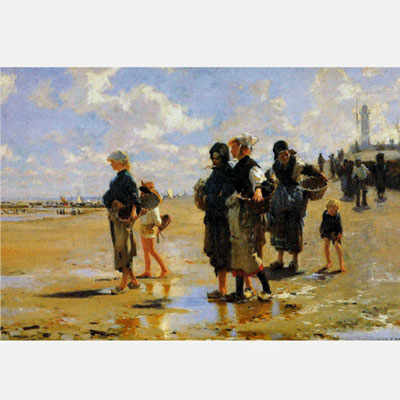
Off to work—John Singer Sargent, Oyster Gatherers of Cancale, 1878, source Drew Smith
Oysters have inspired poets, authors, painters and photographers throughout history. Anton Chekhov wrote a short story titled Oysters. The Irish poet, Seamus Heaney wrote the lively ode to Oysters copied below.
Oysters
Seamus Heaney
Our shells clacked on the plates.
My tongue was a filling estuary,
My palate hung with starlight:
As I tasted the salty Pleiades
Orion dipped his foot into the water.
Alive and violated,
They lay on their bed of ice:
Bivalves: the split bulb
And philandering sigh of ocean
Millions of them ripped and shucked and scattered.
We had driven to that coast
Through flowers and limestone
And there we were, toasting friendship,
Laying down a perfect memory
In the cool of thatch and crockery.
Over the Alps, packed deep in hay and snow,
The Romans hauled their oysters south to Rome:
I saw damp panniers disgorge
The frond-lipped, brine-stung
Glut of privilege
And was angry that my trust could not repose
In the clear light, like poetry or freedom
Leaning in from sea. I ate the day
Deliberately, that its tang
Might quicken me all into verb, pure verb.
The oyster industry provided income and employment to artists in addition to inspiration.
As a teenager Jack London “worked” as a self-styled oyster-pirate, stealing oysters from oyster farms in San Francisco Bay and selling them at a marketplace in Oakland. When his boat became damaged beyond repair, London took a job with the California Fish Patrol, then joined the crew of a Pacific seal-hunting boat and worked in a jute mill before returning to high school in Oakland in 1896. He published his first written work, an account of his time sailing the Pacific titled Typhoon off the Coast of Japan, in the school magazine when he was 17.

Family of oyster merchants in Paris, France, c. 1900, source Drew Smith
References to oysters can be found in Chaucer’s Canterbury Tales and in Shakespeare Merry Wives of Windsor: “Why, then the world’s mine oyster. Which I with sword will open.” The Irish satirist Jonathan Swift is credited with the witty observation that it “was a bold man that first ate on oyster.” Swift was not short of clever one-liners, but in this case he borrowed it from Thomas Fuller’s The History of the Worthies of England , which was published forty years earlier in 1662 and in which the line is attributed to James I. Charles Dickens in The Pickwick Papers, paints what might have been a familiar Thames scene: “It’s a very remarkable circumstance, sir,” said Sam, “that poverty and oysters always seems to go together.” “I don’t understand, Sam,” said Mr Pickwick. “What I mean, sir,” said Sam, “is that the poorer a place is, the greater call there seems to be for oysters. Look here, sir; here’s an oyster stall to every half dozen houses. The street’s lined with ’em. Blessed if I don’t think that when a man’s very poor, he rushes out of his lodgings and eats oysters in reg’lar desperation.”
The correlation between oysters and the poor is yet another fascinating factor documented in the Drew Smith book.
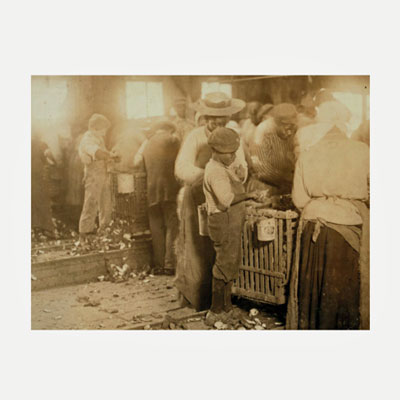
Oyster shuckers at the Varn & Platt Canning Company in Bluffton, South Caroline, 1913. After the abolition of slavery, the oyster industry provided many African Americans, both adults and children, with a means to make a living. Source, Drew Smith
In Lewis Carroll’s “The Walrus and the Carpenter” from 1871 (as told by Tweedledum and Tweedledee to Alice during her adventures in Through the Looking-Glass), the protagonists encounter a bed of oysters and entreat the oysters to join them on their walk. Much to the disapproval of the older wiser oysters, the younger and more gullible go “hopping through the frothy waves, and scrambling to the shore.” Whereupon Carroll notes:
Their coats were brushed, their faces washed, Their shoes were clean and neat —And this was odd, because, you know, They hadn’t any feet. And indeed the young oysters should have heeded their elders’ warning, for the Walrus and Carpenter soon show their true intention: “A loaf of bread,” the Walrus said, “Is what we chiefly need: Pepper and vinegar besides are very good indeed —Now, if you’re ready, Oysters dear, we can begin to feed.” Drew Smith
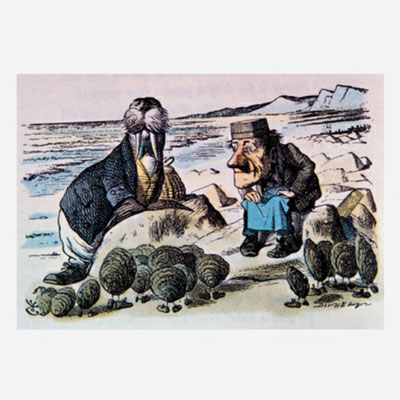
Lewis Carroll’s “The Walrus and the Carpenter” from 1871, illustrated by John Tenniel, source Drew Smith
Gluttony, like lust, was another of the Seven Deadly Sins that could be the result of an oyster fetish. To my knowledge, neither gluttony nor lust nor any of the other deadly sins were encouraged by our menu at the Sea Gull although some patrons may have engaged in activities of which I was unaware.

Sea Gull Cellar Bar Napkin Art-Bonnie artist

Sea Gull Cellar Bar Napkin Art, Bonnie artist

Sea Gull Cellar Bar Napkin Art, Bonnie artist
Rector’s on Broadway was the preferred haunt of the gourmet philanthropist and railway magnate Diamond Jim Brady, who reputedly ordered four dozen Lynnhavens from Baltimore as an appetizer—Lynnhavens being 2 to 3 inches (5 to 7 cm) larger than the Blue Point. One night he supposedly went on to eat with his girlfriend, the actress Lillian Russell, a dozen crabs, a couple of bowls of turtle soup, portions of terrapin, duck, steak, five or six lobsters, a variety of vegetables and pastries, topped off with 2 pounds (910 g) of chocolates. Source: Drew Smith
We did not serve Oyster Stew at the Sea Gull. Had I continued longer at the helm, I’m sure we would have. Leah Eskin provides a simple and soothing recipe in her wonderful book Slices of Life. TITM wrote about her book in our earlier post on the famous Sea Gull pies.
I’ve thought about whether Chaney in Hard Times (see above) got his strength form eating oysters. It’s possible. His story reminds me in a way of The Killers by Hemingway or The Mexican by Jack London. Both Hemingway and London were fans of oysters. We mentioned London a few paragraphs above. Here is what Hemingway had to say about them:
As I ate the oysters with their strong taste of the sea and their faint metallic taste that the cold white wine washed away, leaving only the sea taste and the succulent texture . . . I lost the empty feeling and began to be happy and to make plans.
Ernest Hemingway, A Moveable Feast, 1964

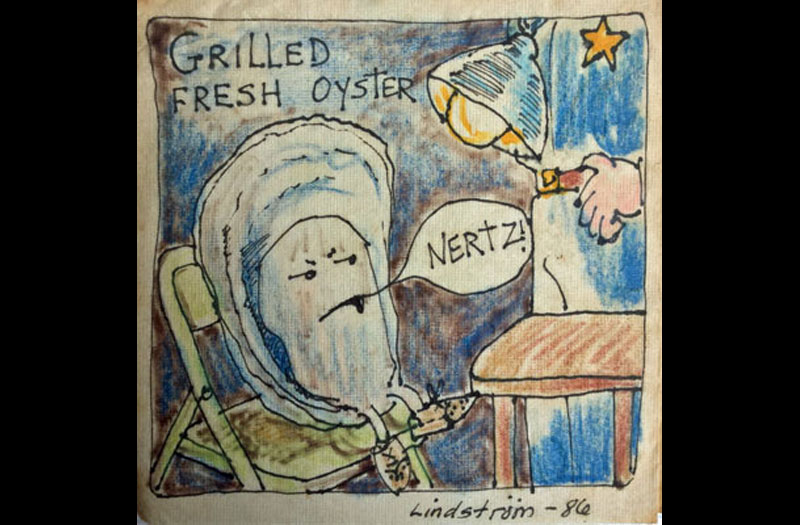
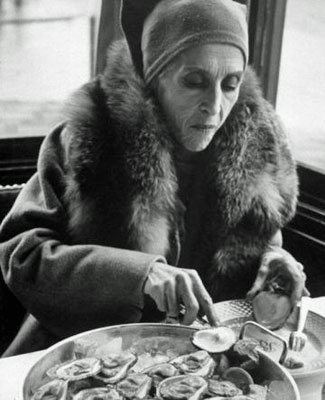
oysters gevalt! ~
I too have rarely met an oyster I didn’t love!
…and it looks like I drew the anon napkin “Oyster Egg”, tho’ my usual icon is “the Oyster Bunny (or: “Binny”)”
Here’s A True Story from the Albion Nation Uprising:
During one of many Road Blockades during the 1992 Resistance to LP’s attempt to liquidate the Albion River Old Growth ‘hood known as the Enchanted Meadow, I happened upon a small group of visiting young people (tourists?) who had built a small fire, & graciously offered me a {delicious} roasted OYSTER!
I invited them {& another of their bivalve delicacies} to join the jolly protest, a short way down the road, where I sought to find a protester who had never eaten an oyster before.
Offering the yummy mollusc to said Blockader, I “filmed” the event ~ as this was my job in the Revolution ~ and proclaimed : ” An Earth First!er’s First Erster!”
Alas, the historic tape of this true event was STOLEN, along with most of my tapes, from a locked cupboard at the ROP facility.
That’s what I’m talk’n bout … inspiring great stories like this. Keep it up! And I’ll correct that napkin to give you credit when I can get to it. Thanks. TITM
I read about all this oyster-eating with the same perverse fascination and gurgling gut as when I read about the baffling gustatory proclivities of distant peoples. Icelandic hakarl, fr’instance, or Cambodian deep-fried tarantula. It’s a wide wonderful world: Ant egg soup! Fermented horse-milk beer! Chocolate-covered locusts! Jellied moose-nose! Casu Marzu (look it up, if you dare)! Yak penis! Mescal worm tacos! And don’t forget the haggis. It’s not just for breakfast anymore.
Oysters make me think of….never mind.